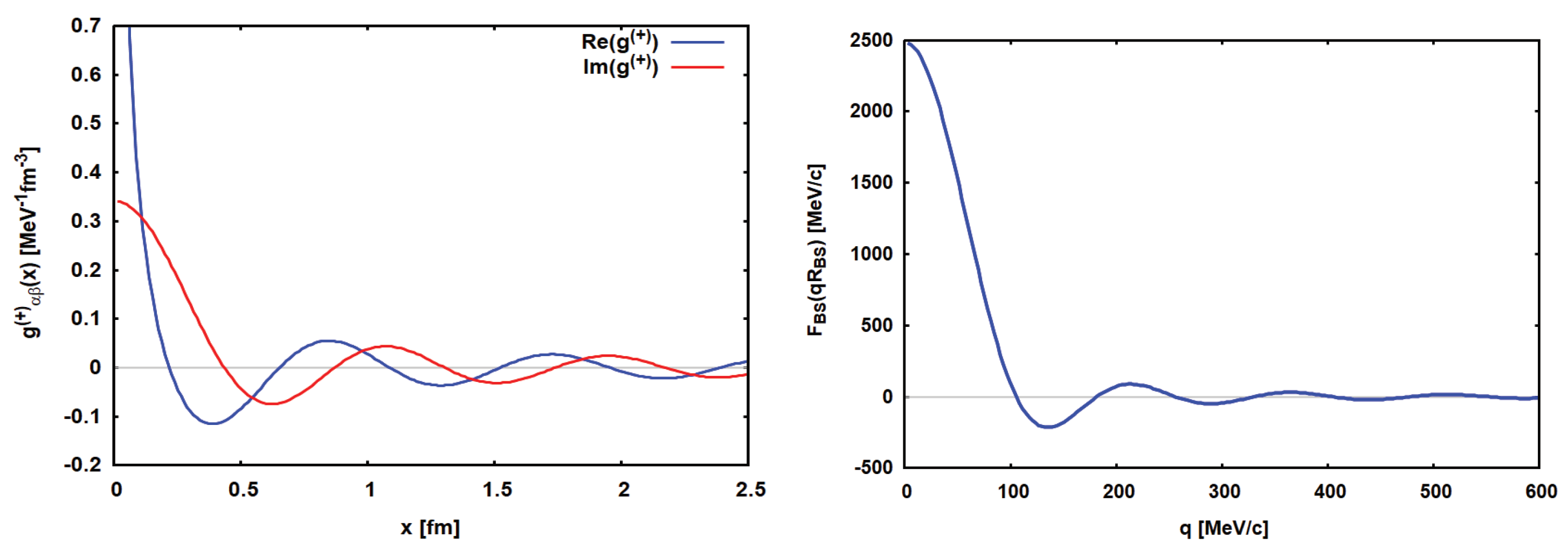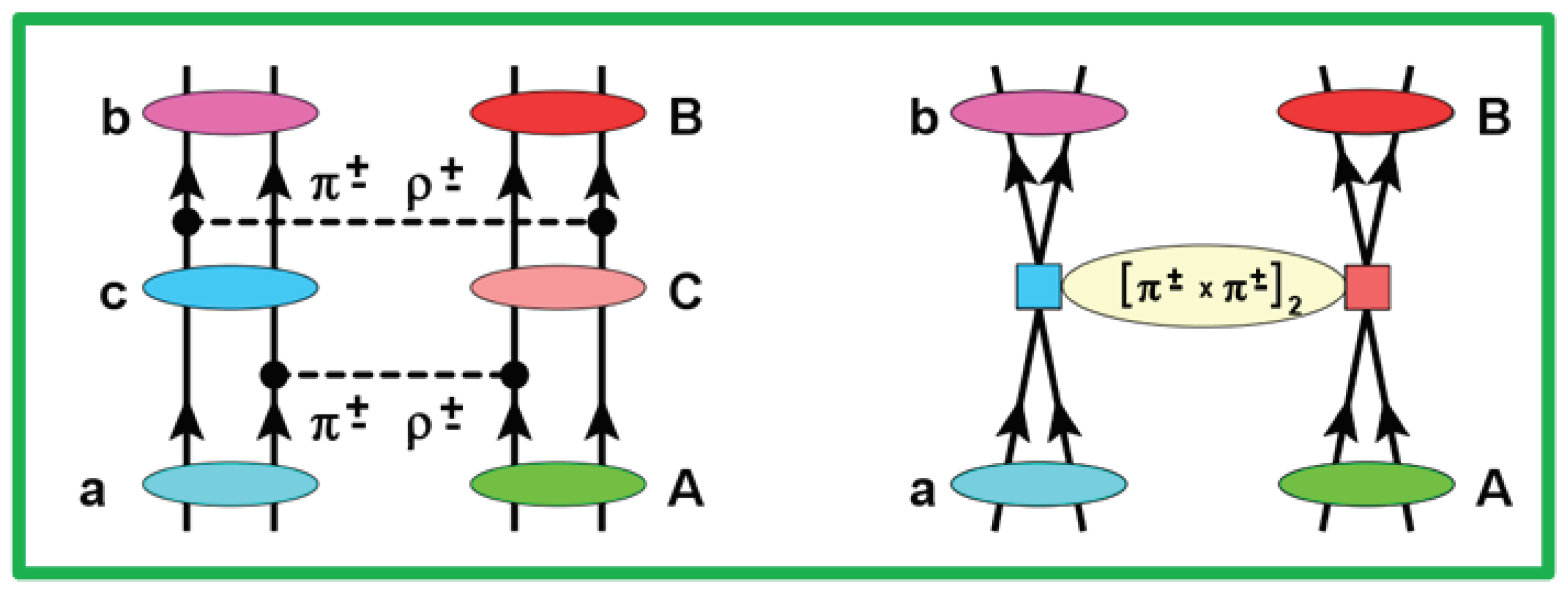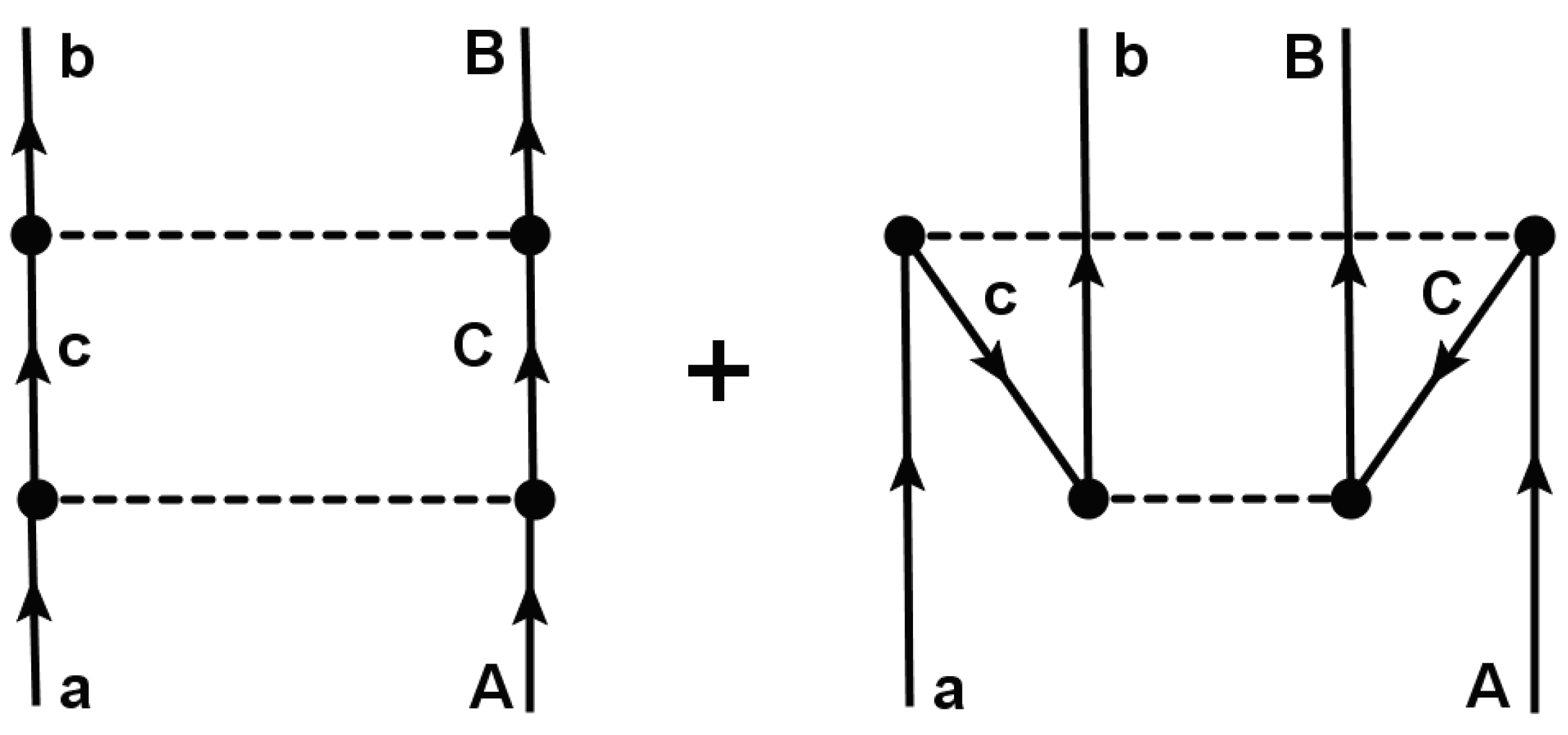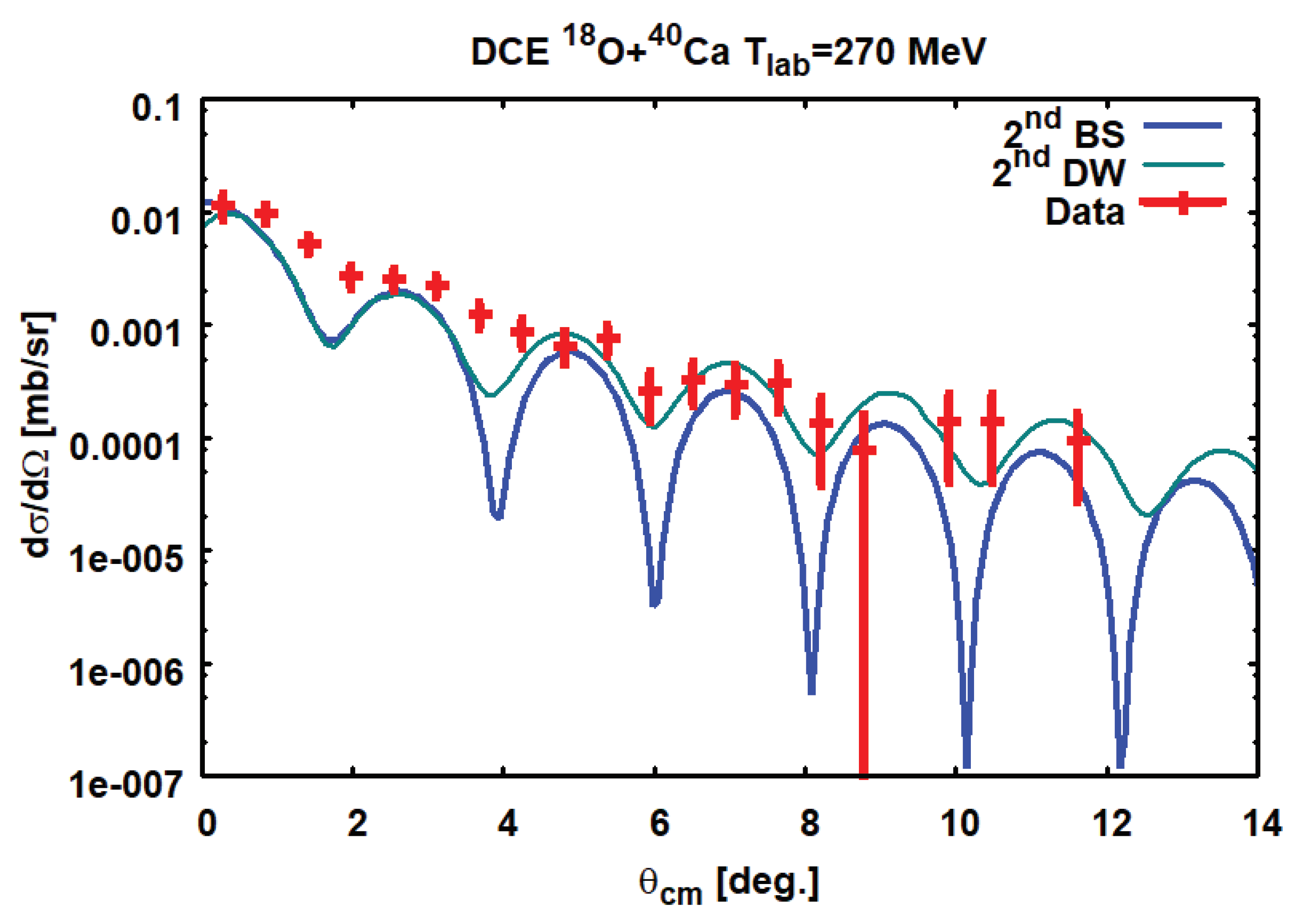1. Introduction
A new era of nuclear spectroscopy with heavy ion beams has begun by the systematic use of heavy ion single charge exchange (SCE) and, very recently, double charge exchange (DCE) reactions. While SCE studies reach back to the last decades of the previous century, DCE investigations are a rather recent application of heavy ion beams [
1,
2]. Heavy ion DCE reactions allow for the first time to study systematically higher order collisional nuclear interactions under the controlled conditions of a peripheral ion–ion reaction.
Compared to the status reached by SCE physics, heavy ion DCE reactions are still in their infancy. Among others, the NUMEN project at LNS Catania [
3] is probably the most advanced initiative on that promising new field of research. Heavy ion DCE research is confronted with a multitude of new challenges in experiment and theory. In a series of previous publications, various aspects of updated SCE and newly formulated DCE theory were presented. In this article, we address two important questions of DCE theory:
What is the role of initial state (ISI) and final state (FSI) ion–ion interactions in spectroscopic studies?
How can we extract nuclear spectroscopic information and nuclear matrix elements from a heavy ion double charge exchange reaction?
Both issues are of vital importance for the aim to use heavy ion DCE reactions as a spectroscopic tool, not to the least as surrogate reactions for double beta decay. Both questions are investigated for double single charge exchange (DSCE) reactions. DCE reactions in general and DSCE reaction in particular are peripheral collisions, corresponding to grazing encounters of the colliding nuclei.
Heavy ion DCE reactions are in general determined by the coherent superposition of three reaction mechanisms of different dynamical origin: There is the rather conventional multi–step transfer mechanism relying on the sequential exchange of proton and neutron pairs between the colliding ion which, in fact, was until very recently the prevailing explanation for the early DCE data [
2]. Transfer processes are mean–field processes driven by the nuclear mean–field, and as such they are probing in the first place single particle and nucleon–pair dynamics, without directly accessing the intrinsic properties of nucleons as e.g. involved in beta–decay.
That deeper level of nuclear dynamics becomes visible only in collisional SCE and DCE processes. With nuclear physics methods the intrinsic isospin structure of the involved hadrons in a many–body environment can be probed in practise either by the exchange of virtual isovector mesons available by nucleon–nucleon (NN) isovector interactions or in pion–nucleon single and double charge exchange reactions. In a heavy ion DCE reaction, these two mechanisms appear in general simultaneously. The virtual meson exchange mechanism leads to the double single charge exchange (DSCE) reaction scenario, given by sequential actions of the NN T–matrix. DSCE is in competition with the Majorana DCE (MDCE) scenario given by a pair of virtual (
) reactions on projectile and target [
1,
2,
4]. The two collisional DCE mechanisms are depicted in
Figure 1.
An additionally appealing aspect of DCE physics is that the same nuclear configurations are accessed as in double beta–decay (DBD). DSCE reactions evolve by form factors which are of a similar diagrammatical structure than the nuclear matrix elements (NME) of two–neutrino () DBD. The MDCE form factors are described by diagrams which are of a striking similarity to those of neutrinoless () DBD. Moreover, DCE reactions and DBD processes proceed by the same kind of spin–isospin operators. However, the origin and strengths of coupling constants differ by orders of magnitude and the internal structure of the interaction vertices is fundamentally different.
Heavy ion reactions involve the complexities of strong initial state (ISI) and final state (FSI) interactions. They affect not only the size of cross sections and shape angular distributions but also the spectroscopy of the involved nuclei. Hence, an important part of DCE physics is to control and understand first elastic ion–ion interactions before safe, quantitative conclusions on the spectroscopic content of the data can be drawn. This problem is nothing new but is being investigated continuously since the early days of heavy ion physics. The optical model underlying direct nuclear theory provides the proper tools for quantitative descriptions of ISI/FSI effects, see e.g. [
5]. The Multi-Methods-Approach used in the NUMEN project [
2] is an indispensable component of experiment and theory in order to take care exactly of that problem. The successful description of DCE reaction data by combination of nuclear multi–step reaction theory and nuclear response function methods is found in [
6]. In this work, we investigate that complexity under a different angle by addressing the interplay of ISI and FSI effects and DCE nuclear matrix elements.
New challenges and features are also encountered in nuclear response functions for second and higher order processes. Although in the past two or so decades a lot of experience has been collected on multi–particle–hole dynamics in low–lying nuclear excitations, see e.g. [
7] for experiment and theory on double–photon emission, only little work has been spent on systematic investigations of nuclear DCE spectroscopy. At present, that gap is being closed by heavy ion DCE reactions. In a previous article [
1] we have discussed already the theoretical methods required to convert second order nuclear reaction results, which are described in a t–channel formalism, to second order nuclear matrix elements, which are s–channel objects. In this article, we present an alternative approach by performing that transformation directly on the operator level with the advantage of obtaining deeper insight into the DCE dynamics and the interplay of reaction and structure physics. As an important result, we find that a DSCE reactions can also be understood as being caused by an effective isotensor interactions, created dynamically in a cooperative manner by the colliding ions.
The mentioned aspects will be discussed for the DSCE reaction mechanism, where the ISI/FSI complex is of general relevance for any second order nuclear reaction of distorted wave two–step character. The special features of relevance for the MDCE scenario will be addressed separately in a follow–up paper. In
Section 2 second order DW reaction theory is recapitulated and the DSCE reaction amplitude is presented in standard second order form. The main result of
Section 2, however, is the introduction of the closure approximation for the DSCE amplitude. In
Section 3, an alternative, new formulation is presented for the DSCE reaction amplitude. The most important aspect is the separation of nuclear structure and reaction dynamics.
Section 4 is devoted to the DSCE–NME. The t–channel operator structure of the product of T–matrices is recasted into s–channel two–body operators acting in projectile and target nucleus. Hence, we reconsider our previous formulation of that problem in [
8] now on the level of operators, rather than on the level of matrix elements. The various aspects of the formalism are illustrated in
Section 5. The discussed issues are summarized, conclusions are drawn, and an outlook to future work is given in
Section 6. The multipole structure of the effective induced isotensor interaction is presented in a number of the appendices. The competing collisional MDCE mechanism by virtual
DCE will be addressed in a follow–up paper.
6. Summary
Starting from a fully microscopic and quantal approach to heavy ion DSCE reaction, the role of initial state (ISI) and final state (FSI) interactions and the induced rank–2 isotensor interaction were investigated. The DSCE amplitude, being of an in principle well known distorted wave two–step structure was reconsidered in an approach which allowed to separate ISI/FSI effects from nuclear matrix elements. ISI/FSI reaction dynamics led to a reaction kernel which was shown to be determined by the shape and size of the ion–ion optical potentials. Applications to data conformed the conjecture that ISI/FSI effects can be understood to a large extent already by the magnitudes of ion–ion total reaction cross sections.
The DSCE form factors and nuclear matrix elements were investigated in closure approximation. The detailed study of the interplay of nuclear structure and reaction dynamically effects led to the interesting result that the intermediate propagation induces correlations by imposing constraints on the DCE vertices and inducing an effective DSCE interaction. The DSCE interaction is obtained for the (tensorial) product of NN T–matrices with rank-0 central spin–scalar and spin–vector interactions and rank–2 spin–tensor interactions. The operator structure of the DSCE interaction was studied and transformed from the reaction theoretical t-channel formulation to the s–channel formalism required for nuclear structure studies and the derivation of nuclear matrix elements.
A briefly mentioned but highly interesting property of the DSCE mechanism or large research potential is that such DCE transitions are well suited to probe the little known rank–2 polarization tensors. They are generalizations of the polarization coefficients given by inversely energy sum rules like the nuclear dipole polarizability obtained from photo–absorption cross sections. The DSCE rank–2 nuclear polarization tensors occur also in
decay and have been studied experimentally and theoretically in nuclear double–gamma decay [
7].
As closing remarks we emphasize that the presented approach is not meant to replace a full microscopic description of DCE reactions. Modern nuclear reaction and nuclear structure theory, as used e.g. in [
6], provide the proper theoretical tools and numerical methods for the quantitative description of processes as complex as a DCE reaction. The purpose of the investigations presented in this article is to clarify the role of ISI/FSI dynamics and their interplay with residual ion–ion interaction in creating correlations and inducing effective isotensor interactions.
Here, we have studied those effects in the context of the DSCE scenario. Since the ISI/FSI effects and their influnence on nuclear matrix elements are of a general character, they are of relevance for any kind of peripheral heavy ion reactions used for spectroscopic studies.








